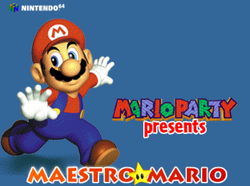Maestro Mario
This article is about a work that used to be available to the public, but is now partially or entirely inaccessible. Details: Much of the game's content is inaccessible, as the game required an internet connection to work.
Our documentation of the subject is inadequate. Only remove this notice if the complete work is recovered and made available publicly.
| Maestro Mario | |
|---|---|

| |
| Developer | POP Multimedia[1] |
| Publisher | Nintendo |
| Platform(s) | Browser |
| Release date | 1999[?] |
| Genre | Rhythm |
| Rating(s) | N/A |
| Mode(s) | Single player |
| Format | Adobe Shockwave |
| Input | Mouse |
Maestro Mario is an Adobe Shockwave game created to promote Mario Party for the Nintendo 64. It was playable from the game's official website alongside Mario's Memory Madness and Wario's Whack Attack, which was eventually repurposed to promote later games in the Mario Party series as well.
Gameplay
Maestro Mario's content is not inherently visible, as the game breaks very soon after launching. The game boots up on a title screen for the program with a unique logo, which almost immediately cuts to a name registration screen at which Mario asks the player to tell him their name. The default text in the name registration box is "Modem." After the player registers a name, the game cuts to a screen with the text "Waiting for connection" on it. The connection always fails, cutting to an error screen that states that "There is no current connection."
To view some of the game's content, the shared.cct file must be decompiled. Upon decompiling the shared.cct file, various alternate graphics for Mario are present, alongside text files providing information about the game. The game appears to have required the user to play music in the same sequence as their opponent, as the text in 20.htm reads "Now it is your turn. Try to play the same sequence." The player's opponent would either challenge the player or be challenged by the player. The player appears to have been able to pick from a list of other players to challenge, as the single line of text in 6.htm reads "Click on a name to challenge for a game.". The player and their opponent also appeared to have the ability to decline a challenge, as there is text present for scenarios in which the opponent accepts and in which there is "no response" from the opponent.
It is possible to view additional content by decompiling the .DCR file as well, as said file also contains additional information about the game. The player and their opponents were all situated in the "Mario club house", which appears to have relied on the internet connection that causes the game to break, since the text "Success! You are now being transferred to the Mario club house!" is located in 28.htm, while multiple error messages and the "Waiting for connection" text are all situated directly before or directly after this text.
Gallery
References
- ^ Mario section on the company's portfolio. popmultimedia.com. Archived from the original on January 5, 2001, 05:29:00 UTC via Wayback Machine. Retrieved July 15, 2023.


